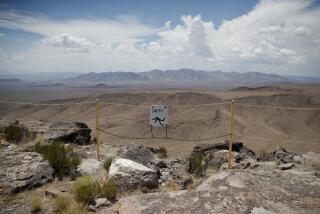U.S. turns to Sweden as model in nuclear waste storage
- Share via
If the United States is at a loss over what to do about nuclear waste, it may be time to check out the Swedish model.
A symposium at the annual meeting of the American Assn. for the Advancement of Science in San Diego last week highlighted the Swedish power industry in gaining public support for a geological repository for high-level radioactive waste.
The Scandinavian success comes in stark contrast to efforts in the U.S., where spent nuclear fuel rods have remained for decades in temporary storage at power plants around the country. Meanwhile, Congress has debated where to bury them, decided on a repository under Yucca Mountain in Nevada, and then changed its mind.
The Obama administration, mindful of the fierce resistance of Senate Majority Leader Harry Reid (D-Nev.), has opposed Yucca and, in the 2011 budget, slashed all funding for the project, which is led by the Department of Energy. Also, President Obama has called for “a new generation of safe, clean nuclear plants” and has budgeted $36 billion in loan guarantees for nuclear power.
Like the U.S., Sweden, which gets 50% of its electricity from nuclear plants, has faced opposition in its three-decade quest to find a suitable long-term burial site. Protests halted studies at several sites.
And the Swedes had a high barrier to overcome: Under Swedish law, any municipality can veto a repository within its borders.
The key, according to Claes Thegerstrom, chief executive of Swedish Nuclear Fuel and Waste Management Co., was a methodical, deliberate process, with a dash of human psychological insight.
Between 1977 and 1985, the company, a private entity acting on behalf of the nuclear industry, studied the geological suitability of 12 sites. It then conducted scientific feasibility studies of eight sites. By 2002, it had narrowed the search to two municipalities, one south and one north of Stockholm.
The industry worked closely with citizens groups, local politicians and civic groups throughout the process. It was a marked contrast, remarked one former Yucca engineer in the audience, to the process in the U.S., where the public comment period to review 6,000 pages of federal documents was 60 days.
“We looked at how we communicated,” Thegerstrom said, adding that the firm gave no intimation that the waste was safe. Instead, “we started with the basic message: This spent fuel is very dangerous. It exists, so we have to find a solution.”
By the time the choice was narrowed to two sites, Thegerstrom noted, “some basic psychological things played a role. One was to have different options. In our case, we got to the point of having competition. That is a strong driving force.”
The two municipalities came to see the repository as a source of jobs and international prestige and were “eager to be selected.”
Another difference: The U.S. effort was led by the Department of Energy, with Congress pulling the strings, canceling the original plan to have one repository in the East and another in the West, instead anointing Yucca.
“There were selection criteria” for geological, tectonic and geochemical suitability, noted Allison Macfarlane, a George Mason University geologist who served on the symposium panel, “but they were abandoned.”
Thegerstrom said the national government in Sweden, once it enacted a law allowing a repository, maintained a hands-off policy as to its location, allowing industry officials to make the decision, in consultation with local government.
“In Sweden, the industry is responsible,” he said. “But in the U.S., the industry is absent from the nuclear waste discussion. That seems very strange.”
The Swedish underground repository, in crystalline bedrock, is expected to be built by 2020.
Macfarlane, recently appointed to Obama’s Blue Ribbon Commission on America’s Nuclear Future, said upcoming decisions in the U.S. should include geologists “in a decision-making role” and allow communities to reject sites.
Multiple repositories will be needed, not only because there is too much waste for Yucca alone, even if it were to be revived, but also, she said, “to restore a sense of fairness and share the burden.”
The U.S. should consider “moving waste management out” of the Department of Energy, Macfarlane suggested, perhaps into a public-private partnership.
The big question, she added, is: “Can we resolve the nuclear waste issue before we have a large expansion of nuclear energy?”
margot.roosevelt@ latimes.com
More to Read
Sign up for Essential California
The most important California stories and recommendations in your inbox every morning.
You may occasionally receive promotional content from the Los Angeles Times.














